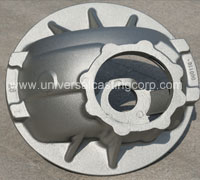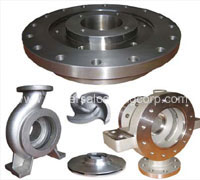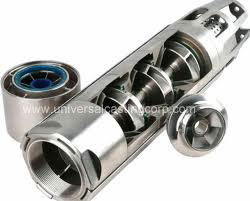
UNIVERSAL CASTING CORPORATION
Manufacturer of : Ferrous & Non Ferrous Castings
(Specialization in Graded Graded Cast Iron Pressure Rolls)
Our Products
Manufacturer & Exporter of Stainless Steel Castings
We are offering our clients, Stainless Steel Castings. These are widely appreciated by our clients for their strength, durability and corrosion resistance. We can provide these in customized sizes and specifications in accordance with the requirements of our esteemed clients.
A casting made from stainless steel. Stainless steel is a steel alloy with a minimum of 10.5 or 11% chromium content by mass. Stainless steel does not stain, corrode, or rust as easily as ordinary steel (it stains less, but it is not stain-proof). There are different grades and surface finishes of stainless steel to suit the environment to which the material will be subjected in its lifetime.



Manufacturing Capacity : From 10 kgs. to 1 Ton Single PC.
Specifications -
Stainless Steel - Grade 304 (UNS S30400)
Grade 304L, the low carbon version of 304, does not require post-weld annealing and so is extensively used in heavy gauge components (over about 6mm). Grade 304H with its higher carbon content finds application at elevated temperatures. The austenitic structure also gives these grades excellent toughness, even down to cryogenic temperatures.
Grade 304 is the standard "18/8" stainless; it is the most versatile and most widely used stainless steel, available in a wider range of products, forms and finishes than any other. It has excellent forming and welding characteristics. The balanced austenitic structure of Grade 304 enables it to be severely deep drawn without intermediate annealing, which has made this grade dominant in the manufacture of drawn stainless parts such as sinks, hollow-ware and saucepans. For these applications it is common to use special "304DDQ" (Deep Drawing Quality) variants. Grade 304 is readily brake or roll formed into a variety of components for applications in the industrial, architectural, and transportation fields. Grade 304 also has outstanding welding characteristics. Post-weld annealing is not required when welding thin sections.
Key Properties
These properties are specified for flat rolled product (plate, sheet and coil) in ASTM A240/A240M. Similar but not necessarily identical properties are specified for other products such as pipe and bar in their respective specifications.
Chemical Composition
Typical compositional ranges for grade 304 stainless steels are given in table 1.
Table 1. Composition ranges for 304 grade stainless steel
Mechanical Properties
Typical mechanical properties for grade 304 stainless steels are given in table 2.
Table 2. Mechanical properties of 304 grade stainless steel
Physical Properties
Typical physical properties for annealed grade 304 stainless steels are given in table 3.
Table 3. Physical properties of 304 grade stainless steel in the annealed condition.
Grade Specification Comparison
Approximate grade comparisons for 304 stainless steels are given in table 4.
Table 4. Grade specifications for 304 grade stainless steel.
Possible Alternative Grades
Possible alternative grades to grade 304 stainless steels are given in table 5.
Table 5. Possible alternative grades to 304 grade stainless steel
Stainless Steel - Grade 316 (UNS S31600)
Grade 316 is the standard molybdenum-bearing grade, second in importance to 304 amongst the austenitic stainless steels. The molybdenum gives 316 better overall corrosion resistant properties than Grade 304, particularly higher resistance to pitting and crevice corrosion in chloride environments. It has excellent forming and welding characteristics. It is readily brake or roll formed into a variety of parts for applications in the industrial, architectural, and transportation fields. Grade 316 also has outstanding welding characteristics. Post-weld annealing is not required when welding thin sections.
Grade 316L, the low carbon version of 316 and is immune from sensitisation (grain boundary carbide precipitation). Thus it is extensively used in heavy gauge welded components (over about 6mm). Grade 316H, with its higher carbon content has application at elevated temperatures, as does stabilised grade 316Ti.
The austenitic structure also gives these grades excellent toughness, even down to cryogenic temperatures.
Key Properties
These properties are specified for flat rolled product (plate, sheet and coil) in ASTM A240/A240M. Similar but not necessarily identical properties are specified for other products such as pipe and bar in their respective specifications.
Chemical Composition
Table 1. Composition ranges for 316 grade of stainless steels.
Mechanical Properties
Table 2. Mechanical properties of 316 grade stainless steels.
Physical Properties
Table 3. Typical physical properties for 316 grade stainless steels.
Grade Specification Comparison
Table 4. Grade specifications for 316 grade stainless steels.
Possible Alternative Grades
Table 5. Possible alternative grades to 316 stainless steel.
We are offering our clients, Stainless Steel Castings. These are widely appreciated by our clients for their strength, durability and corrosion resistance. We can provide these in customized sizes and specifications in accordance with the requirements of our esteemed clients.
A casting made from stainless steel. Stainless steel is a steel alloy with a minimum of 10.5 or 11% chromium content by mass. Stainless steel does not stain, corrode, or rust as easily as ordinary steel (it stains less, but it is not stain-proof). There are different grades and surface finishes of stainless steel to suit the environment to which the material will be subjected in its lifetime.



Manufacturing Capacity : From 10 kgs. to 1 Ton Single PC.
Specifications -
- IS -304
- IS -316
- All Grades better Corrosion, wear and heat resisting
Stainless Steel - Grade 304 (UNS S30400)
Grade 304L, the low carbon version of 304, does not require post-weld annealing and so is extensively used in heavy gauge components (over about 6mm). Grade 304H with its higher carbon content finds application at elevated temperatures. The austenitic structure also gives these grades excellent toughness, even down to cryogenic temperatures.
Grade 304 is the standard "18/8" stainless; it is the most versatile and most widely used stainless steel, available in a wider range of products, forms and finishes than any other. It has excellent forming and welding characteristics. The balanced austenitic structure of Grade 304 enables it to be severely deep drawn without intermediate annealing, which has made this grade dominant in the manufacture of drawn stainless parts such as sinks, hollow-ware and saucepans. For these applications it is common to use special "304DDQ" (Deep Drawing Quality) variants. Grade 304 is readily brake or roll formed into a variety of components for applications in the industrial, architectural, and transportation fields. Grade 304 also has outstanding welding characteristics. Post-weld annealing is not required when welding thin sections.
Key Properties
These properties are specified for flat rolled product (plate, sheet and coil) in ASTM A240/A240M. Similar but not necessarily identical properties are specified for other products such as pipe and bar in their respective specifications.
Chemical Composition
Typical compositional ranges for grade 304 stainless steels are given in table 1.
Table 1. Composition ranges for 304 grade stainless steel
| Grade | C | Mn | Si | P | S | Cr | Mo | Ni | N | |
| 304 | min. | - | - | - | - | - | 18.0 | - | 8.0 | - |
| max. | 0.08 | 2.0 | 0.75 | 0.045 | 0.030 | 20.0 | - | 10.5 | 0.10 | |
| 304L | min. | - | - | - | - | - | 18.0 | - | 8.0 | - |
| max. | 0.030 | 2.0 | 0.75 | 0.045 | 0.030 | 20.0 | 12.0 | 0.10 | ||
| 304H | min. | 0.04 | - | - | - | - | 18.0 | - | 8.0 | - |
| max. | 0.10 | 2.0 | 0.75 | 0.045 | 0.030 | 20.0 | - | 10.5 | - | |
Mechanical Properties
Typical mechanical properties for grade 304 stainless steels are given in table 2.
Table 2. Mechanical properties of 304 grade stainless steel
| Grade | Tensile Strength (MPa) min | Yield Strength 0.2% Proof (MPa) min | Elongation (% in 50mm) min | Hardness | |
| Rockwell B (HR B) max | Brinell (HB) max | ||||
| 304 | 515 | 205 | 40 | 92 | 201 |
| 304L | 485 | 170 | 40 | 92 | 201 |
| 304H | 515 | 205 | 40 | 92 | 201 |
| 304H also has a requirement for a grain size of ASTM No 7 or coarser. | |||||
Physical Properties
Typical physical properties for annealed grade 304 stainless steels are given in table 3.
Table 3. Physical properties of 304 grade stainless steel in the annealed condition.
| Grade | Density (kg/m3) | Elastic Modulus (GPa) | Mean Coefficient of Thermal Expansion (µm/m/°C) | Thermal Conductivity (W/m.K) | Specific Heat 0-100°C (J/kg.K) |
Electrical Resistivity (nO.m) | |||
| 0-100°C | 0-315°C | 0-538°C | at 100°C | at 500°C | |||||
| 304/L/H | 8000 | 193 | 17.2 | 17.8 | 18.4 | 16.2 | 21.5 | 500 | 720 |
Grade Specification Comparison
Approximate grade comparisons for 304 stainless steels are given in table 4.
Table 4. Grade specifications for 304 grade stainless steel.
| Grade | UNS No | Old British | Euronorm | Swedish SS | Japanese JIS | ||
| BS | En | No | Name | ||||
| 304 | S30400 | 304S31 | 58E | 1.4301 | X5CrNi18-10 | 2332 | SUS 304 |
| 304L | S30403 | 304S11 | - | 1.4306 | X2CrNi19-11 | 2352 | SUS 304L |
| 304H | S30409 | 304S51 | - | 1.4948 | X6CrNi18-11 | - | - |
| These comparisons are approximate only. The list is intended as a comparison of functionally similar materials not as a schedule of contractual equivalents. If exact equivalents are needed original specifications must be consulted. | |||||||
Possible Alternative Grades
Possible alternative grades to grade 304 stainless steels are given in table 5.
Table 5. Possible alternative grades to 304 grade stainless steel
| Grade | Why it might be chosen instead of 304 |
| 301L | A higher work hardening rate grade is required for certain roll formed or stretch formed components. |
| 302HQ | Lower work hardening rate is needed for cold forging of screws, bolts and rivets. |
| 303 | Higher machinability needed, and the lower corrosion resistance, formability and weldability are acceptable. |
| 316 | Higher resistance to pitting and crevice corrosion is required, in chloride environments |
| 321 | Better resistance to temperatures of around 600-900°C is needed.321 has higher hot strength. |
| 3CR12 | A lower cost is required, and the reduced corrosion resistance and resulting discolouration are acceptable. |
| 430 | A lower cost is required, and the reduced corrosion resistance and fabrication characteristics are acceptable. |
Stainless Steel - Grade 316 (UNS S31600)
Grade 316 is the standard molybdenum-bearing grade, second in importance to 304 amongst the austenitic stainless steels. The molybdenum gives 316 better overall corrosion resistant properties than Grade 304, particularly higher resistance to pitting and crevice corrosion in chloride environments. It has excellent forming and welding characteristics. It is readily brake or roll formed into a variety of parts for applications in the industrial, architectural, and transportation fields. Grade 316 also has outstanding welding characteristics. Post-weld annealing is not required when welding thin sections.
Grade 316L, the low carbon version of 316 and is immune from sensitisation (grain boundary carbide precipitation). Thus it is extensively used in heavy gauge welded components (over about 6mm). Grade 316H, with its higher carbon content has application at elevated temperatures, as does stabilised grade 316Ti.
The austenitic structure also gives these grades excellent toughness, even down to cryogenic temperatures.
Key Properties
These properties are specified for flat rolled product (plate, sheet and coil) in ASTM A240/A240M. Similar but not necessarily identical properties are specified for other products such as pipe and bar in their respective specifications.
Chemical Composition
Table 1. Composition ranges for 316 grade of stainless steels.
| Grade | C | Mn | Si | P | S | Cr | Mo | Ni | N | |
| 316 | min. | - | - | - | - | - | 16.0 | 2.00 | 10.0 | - |
| max. | 0.08 | 2.0 | 0.75 | 0.045 | 0.03 | 18.0 | 3.00 | 14.0 | 0.10 | |
| 316L | min. | - | - | - | - | - | 16.0 | 2.00 | 10.0 | - |
| max. | 0.030 | 2.0 | 0.75 | 0.045 | 0.03 | 18.0 | 3.00 | 14.0 | 0.10 | |
| 316H | min. | 0.04 | 0.04 | - | - | - | 16.0 | 2.00 | 10.0 | - |
| max. | 0.10 | 0.10 | 0.75 | 0.045 | 0.03 | 18.0 | 3.00 | 14.0 | - | |
Mechanical Properties
Table 2. Mechanical properties of 316 grade stainless steels.
| Grade | Tensile Str (MPa) min | Yield Strength 0.2% Proof (MPa) min | Elong(% in 50mm) min | Hardness | |
| Rockwell B (HR B) max | Brinell (HB) max | ||||
| 316 | 515 | 205 | 40 | 95 | 217 |
| 316L | 485 | 170 | 40 | 95 | 217 |
| 316H | 515 | 205 | 40 | 95 | 217 |
Physical Properties
Table 3. Typical physical properties for 316 grade stainless steels.
| Grade | Density (kg/m3) | Elastic Modulus (GPa) | Mean Coefficient of Thermal Expansion (µm/m/°C) |
Thermal Conductivity (W/m.K) |
Specific Heat 0-100°C (J/kg.K) |
Electrical Resistivity (nO.m) | |||
| 0-100°C | 0-315°C | 0-538°C | at 100°C | at 500°C | |||||
| 316/L/H | 8000 | 193 | 15.9 | 16.2 | 17.5 | 16.3 | 21.5 | 500 | 740 |
Grade Specification Comparison
Table 4. Grade specifications for 316 grade stainless steels.
| Grade | UNS No | Old British | Euronorm | Swedish SS | Japanese JIS | ||
| BS | En | No | Name | ||||
| 316 | S31600 | 316S31 | 58H, 58J | 1.4401 | X5CrNiMo17-12-2 | 2347 | SUS 316 |
| 316L | S31603 | 316S11 | - | 1.4404 | X2CrNiMo17-12-2 | 2348 | SUS 316L |
| 316H | S31609 | 316S51 | - | - | - | - | - |
| Note: These comparisons are approximate only. The list is intended as a comparison of functionally similar materials not as a schedule of contractual equivalents. If exact equivalents are needed original specifications must be consulted | |||||||
Possible Alternative Grades
Table 5. Possible alternative grades to 316 stainless steel.
| Grade | Why it might be chosen instead of 316 |
| 316Ti | Better resistance to temperatures of around 600-900°C is needed. |
| 316N | Higher strength than standard 316. |
| 317L | Higher resistance to chlorides than 316L, but with similar resistance to stress corrosion cracking. |
| 904L | Much higher resistance to chlorides at elevated temperatures, with good formability. |
| 2205 | Much higher resistance to chlorides at elevated temperatures, and higher strength than 316. |

